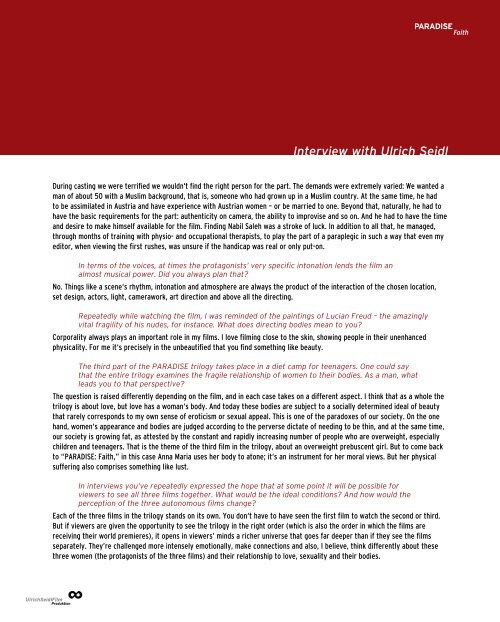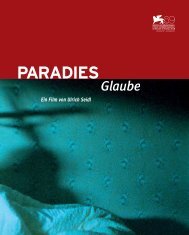Download - Paradies Trilogie von Ulrich Seidl
Download - Paradies Trilogie von Ulrich Seidl
Download - Paradies Trilogie von Ulrich Seidl
Erfolgreiche ePaper selbst erstellen
Machen Sie aus Ihren PDF Publikationen ein blätterbares Flipbook mit unserer einzigartigen Google optimierten e-Paper Software.
Interview avec <strong>Ulrich</strong> <strong>Seidl</strong> Interview with <strong>Ulrich</strong> <strong>Seidl</strong><br />
During casting we were terrified we wouldn‘t find the right person for the part. The demands were extremely varied: We wanted a<br />
man of about 50 with a Muslim background, that is, someone who had grown up in a Muslim country. At the same time, he had<br />
to be assimilated in Austria and have experience with Austrian women – or be married to one. Beyond that, naturally, he had to<br />
have the basic requirements for the part: authenticity on camera, the ability to improvise and so on. And he had to have the time<br />
and desire to make himself available for the film. Finding Nabil Saleh was a stroke of luck. In addition to all that, he managed,<br />
through months of training with physio- and occupational therapists, to play the part of a paraplegic in such a way that even my<br />
editor, when viewing the first rushes, was unsure if the handicap was real or only put-on.<br />
In terms of the voices, at times the protagonists‘ very specific intonation lends the film an<br />
almost musical power. Did you always plan that?<br />
No. Things like a scene‘s rhythm, intonation and atmosphere are always the product of the interaction of the chosen location,<br />
set design, actors, light, camerawork, art direction and above all the directing.<br />
Repeatedly while watching the film, I was reminded of the paintings of Lucian Freud – the amazingly<br />
vital fragility of his nudes, for instance. What does directing bodies mean to you?<br />
Corporality always plays an important role in my films. I love filming close to the skin, showing people in their unenhanced<br />
physicality. For me it‘s precisely in the unbeautified that you find something like beauty.<br />
The third part of the PARADISE trilogy takes place in a diet camp for teenagers. One could say<br />
that the entire trilogy examines the fragile relationship of women to their bodies. As a man, what<br />
leads you to that perspective?<br />
The question is raised differently depending on the film, and in each case takes on a different aspect. I think that as a whole the<br />
trilogy is about love, but love has a woman‘s body. And today these bodies are subject to a socially determined ideal of beauty<br />
that rarely corresponds to my own sense of eroticism or sexual appeal. This is one of the paradoxes of our society. On the one<br />
hand, women‘s appearance and bodies are judged according to the perverse dictate of needing to be thin, and at the same time,<br />
our society is growing fat, as attested by the constant and rapidly increasing number of people who are overweight, especially<br />
children and teenagers. That is the theme of the third film in the trilogy, about an overweight prebuscent girl. But to come back<br />
to “PARADISE: Faith,” in this case Anna Maria uses her body to atone; it‘s an instrument for her moral views. But her physical<br />
suffering also comprises something like lust.<br />
In interviews you‘ve repeatedly expressed the hope that at some point it will be possible for<br />
viewers to see all three films together. What would be the ideal conditions? And how would the<br />
perception of the three autonomous films change?<br />
Each of the three films in the trilogy stands on its own. You don‘t have to have seen the first film to watch the second or third.<br />
But if viewers are given the opportunity to see the trilogy in the right order (which is also the order in which the films are<br />
receiving their world premieres), it opens in viewers’ minds a richer universe that goes far deeper than if they see the films<br />
separately. They’re challenged more intensely emotionally, make connections and also, I believe, think differently about these<br />
three women (the protagonists of the three films) and their relationship to love, sexuality and their bodies.



